Does your little one have their first loose tooth? If so, they might react with excitement — but they might also feel a bit of anxiety. How can you calm their fears?
As a parent, your kids look to you for comfort. Here’s how you can talk to your kids about their loose teeth to assuage their worries and maybe teach a bit of a science lesson, too.
1. Tell a Story
There’s no rule saying that you have to tell the traditional tooth fairy tale. Maybe, like in the Spanish tradition, you want to tell a story about a mouse who takes their shed incisor in exchange for money or a small gift.
Make it a homeschool assignment that you do together — researching various tooth traditions from around the world. This project serves two purposes. It’s fun and educational, and your child will feel less alone knowing that their loss is a universal experience.
2. Talk About Biology
Of course, you don’t want your kids only to know fictional tales about lost teeth. You want them to understand the science, so find some online resources — your dentist may suggest some — and answer the “why do my teeth fall out” question.
You’ll learn how the adult teeth push on their baby teeth’s roots as they begin to grow. When the root of each baby tooth starts to separate, they get loose.
Now is also the ideal time to introduce what to do when an adult tooth becomes loose. Explain that this phenomenon typically only occurs due to a blunt force injury. Emphasize that your child should immediately tell a grown up if this happens to one of their new teeth so that they can seek dental attention.
3. Let Them Wiggle a Bit
Children fall into two categories when it comes to loose teeth. Some of them want your assistance at removing the wriggling incisor. Others take a hands’ off approach and prefer to manage the job solo.
Fortunately, it’s safe to let little fingers explore wiggling their teeth — please don’t worry that they might harm themselves. If they anticipate a prize from the mythical fairy, they may put in considerable effort.
4. Reinforce Proper Hygiene
Of course, cold and flu season has arrived, and COVID-19 seems determined to linger despite everyone’s wish that the nasty germ would depart. When your child puts their hands in their mouth, they can introduce all kinds of pathogens. If they have any tiny cuts, the virus or bacteria can directly enter the bloodstream and bam — you have a sick kid.
Fortunately, kids tend to start losing teeth around age six, which is the ideal time to reinforce hygiene practices like handwashing. Review the proper technique and remind children to use hand sanitizer when a sink isn’t available — but to wait until the gel completely dries before putting fingers in their mouths.
5. Keep Up With Brushing and Flossing
When your child gets a loose tooth, they may ramp up their efforts to whine about brushing. Please don’t give in to their pleas that it’s uncomfortable. They need to keep their mouths clean to prevent cavities, particularly once their adult teeth begin emerging.
According to the American Dental Association, you should brush twice daily and floss once. Excessive brushing, such as after every meal, strips away the enamel, increasing cavity risk. If your child complains about floss cutting their fingers, try switching to a tape version or models with plastic handles.
6. Assuage Their Fears
Some children do have considerable anxiety about losing teeth. If yours seems unusually sensitive, please help them practice relaxation techniques to restore calm.
Children can benefit from meditation like adults, although they might not sit as long — try one minute for each year of age. They can also practice yoga if you bring it to their level. Have them breathe while arching their backs like scared Halloween kitties.
7. Feed Them a Healthy Diet
Your children need a healthy diet to develop their adult teeth. Keep your meal prep game on point so that you provide the vital nutrients for their development.
Do keep in mind that your child’s preferences may change as they develop loose teeth. You can prepare a soft-food diet that won’t put pressure on any wiggly incisors or molars. Encourage your little ones to snack on cheese for calcium.
8. See Their Dentist Regularly
Finally, you’ll want to keep up with your child’s dental appointments as they start shedding baby teeth and developing adult ones. Your provider can monitor their development and advise you of any potential problems.
Some children are more prone to cavities than others. Fortunately, today’s fillings look more natural if they need to have any addressed — they won’t have the signature mouth full of metal as in decades past.
Talk to Your Kids About Their Loose Teeth
As a parent, you should talk to your kids about their loose teeth. Doing so will assuage their fears and teach them a bit about human development.


